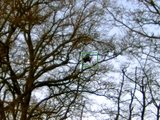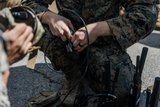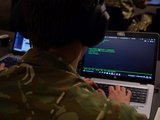US Army to receive more soldier-borne video terminals
One System Remote Video Terminal. (Photo: Textron)
Sole bidder Textron has received a $92.53 million contract to provide more One System Remote Video Terminal (OSRVT) and Soldier Portable OSRVT (SPOT) units for the US Army.
It will also provide contractor logistics support and complete work by 7 February 2024, the DoD noted in a 3 June announcement.
Textron has delivered the OSRVT since 2011 under a programme of record. Users include the US Army, USMC and SOF.
OSRVT delivers full-motion video, images and critical geospatial data from various sources ‘directly to the warfighter’s fingertips’, the company claims.
The original OSRVT has been upgraded with a bidirectional capability, upgraded software architecture and user-friendlier interface.
SPOT includes portable antennas, a multi-band transceiver and a ruggedised computer.
More from Digital Battlespace
-
![Chess Dynamics successfully demonstrates Vision4ce AI-driven tracker]()
Chess Dynamics successfully demonstrates Vision4ce AI-driven tracker
The Vision4ce Deep Embedded Feature Tracking (DEFT) technology software is designed to process video and images by blending traditional computer vision with artificial intelligence (AI) algorithms to present actionable information from complex environments.
-
![Wave Relay devices cleared for security use on commercial systems in industry trend]()
Wave Relay devices cleared for security use on commercial systems in industry trend
Persistent Systems has been cleared by National Security Agency (NSA) to transmit sensitive data on commercial networks. The devices are added to the NSA’s Commercial Solutions for Classified (CSfC) component list which also includes other companies’ products providing the same security.
-
![UK teases cyber spending boost in Strategic Defence Review ahead of “imminent” release]()
UK teases cyber spending boost in Strategic Defence Review ahead of “imminent” release
The release of the UK’s Strategic Defence Review (SDR) has been long promised as mid-year. It is possible it could be as early as 2 June although the UK Ministry of Defence (MoD) continues to play its cards close to its chest.
-
![Intelsat emphasises SATCOM resilience for SOF in contested domains (video)]()
Intelsat emphasises SATCOM resilience for SOF in contested domains (video)
Intelsat outlines how its multi-orbit SATCOM architecture is enhancing connectivity and resilience for special operations forces operating in degraded and contested environments.
-
![US Space Force’s next-generation missile warning system moves forward with $500 million in new contracts]()
US Space Force’s next-generation missile warning system moves forward with $500 million in new contracts
Next-Generation Overhead Persistent Infrared (Next-Gen OPIR) satellites are intended to provide early warning of missile launches from any location worldwide and new ground stations will result in expanded coverage of critical missile warning.






















